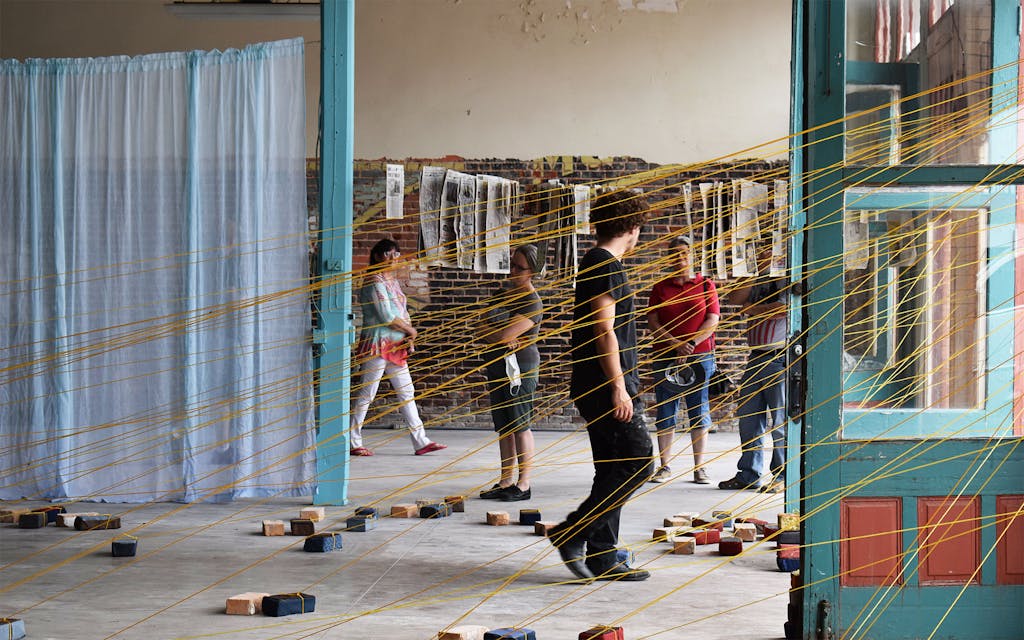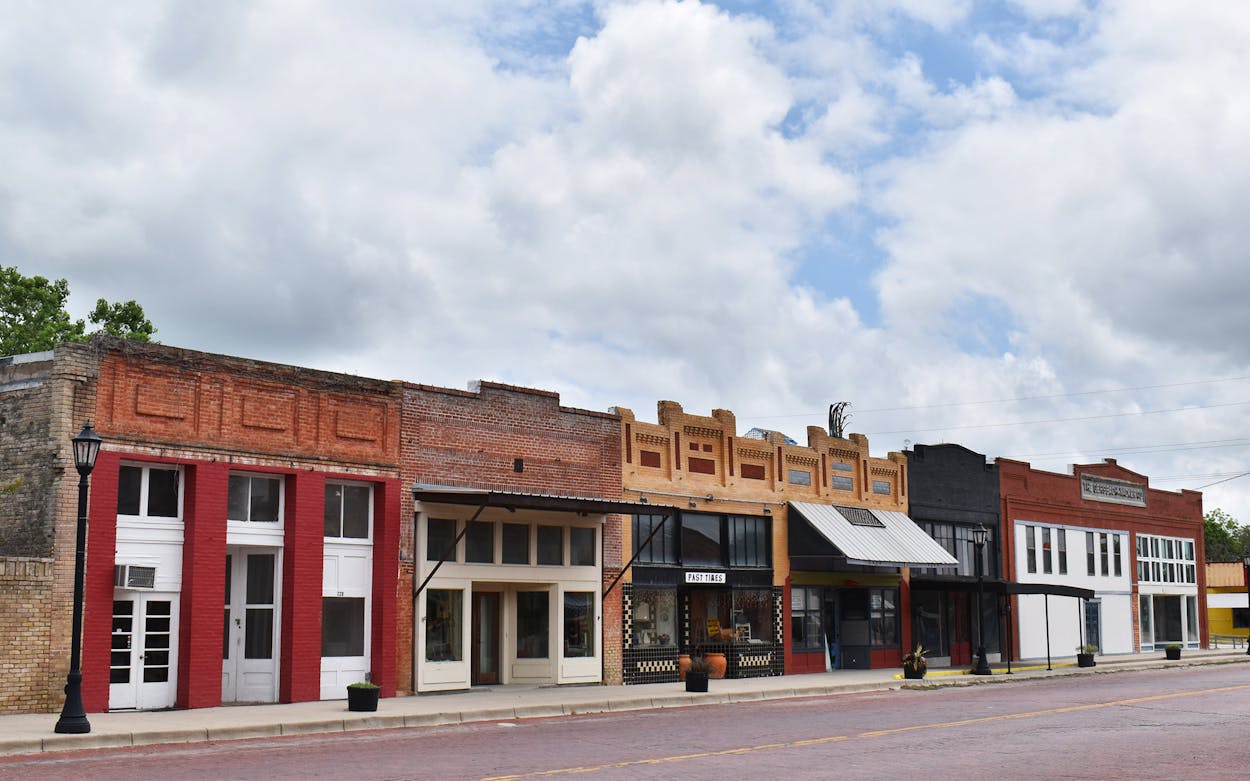Clark Street, the main drag in the small town of Bartlett, seems suspended in time. More than a dozen rust-colored brick storefronts are stark against the cerulean sky; most date back to the early 1900s. When I first step onto the sidewalk, the place is eerily silent. But it’s not long before the stillness breaks, with the noise of cars rattling down the red cobblestone street on the way to bigger towns like Georgetown or Temple.
About an hour northeast of Austin, straddling Williamson and Bell counties, Bartlett sits along Texas Highway 95, east of Interstate 35. With its mostly vacant storefronts—a few are still occupied, including by a German restaurant and a handcrafted furniture store—Bartlett appears at first glance to be “the town that time forgot,” as Jonas Criscoe, founding member of Austin-based artist collective ICOSA, puts it.
Bartlett has been labeled a ghost town by many who come across it, mistaking its stillness for total abandonment. And it has literally been portrayed as one: a popular filming location, the town is listed on the Texas Film Commission’s Fear the Walking Dead Trail, after its appearance in Fear The Walking Dead‘s fourth season as a postapocalyptic shell of a town.
But it isn’t one. While the railroad and cotton industries that once thrived here are long gone, about 1,700 people still live within Bartlett’s just over one square mile.
Robert Zalkin, an entrepreneur from Liberty, New York, seems to believe Bartlett could be the next Lockhart or Georgetown—a revitalized community attracting artists and creative types priced out of Austin. Zalkin bought more than a dozen of Bartlett’s vacant buildings in 2019, hoping to turn them into shops, restaurants, and art spaces. So far, a liquor store has opened, as well as a bed-and-breakfast in what used to be one of the town’s banks. After Criscoe happened upon Bartlett while on a drive with his family, and later came across Zalkin’s project in a classified ad, he approached Zalkin about converting one of the buildings into an artist residency space. The idea eventually morphed into a site-specific art installation, “The Bartlett Project,” on view through August 21.
Curator Leslie Moody Castro was first attracted to the project after the area was described to her as a ghost town. But after immersing herself in the community this past spring and getting to know residents—she attended the local American Legion chapter’s spaghetti fundraiser and cheered on Bartlett High School’s class of 2021 at graduation—she’s become one of its most vehement defenders against the misnomer.
“When you pass through, it looks like [Clark Street is] the only thing in the town,” says Moody Castro, who has been living in Bartlett on and off over the past three months. “And that’s something that we’ve really been struggling with, because clearly to call something a ghost town means that it doesn’t exist anymore, when the opposite in Bartlett is true.”
“The Bartlett Project” highlights a town that is very much alive. It has transformed one of the vacant buildings downtown, 221 E. Clark, into a gallery space with more than a dozen sculptures, a multimedia collage piece, and oral histories broadcast on a low-frequency radio station. Four Texas artists—Aimèe Everett, M.E. Laursen, Jade Walker, and Mark Menjivar—have created thought-provoking pieces that pay tribute to the town’s past and gesture toward its future.
Before the building was abandoned two decades ago, it variously served as a dollar store, an appliance store, and an embalming studio. Today its downstairs is one large room, offering much more space than a standard white-walled gallery. The peeling blue, red, and sand-colored walls remain empty, and the lack of labels and solid boundaries facilitate the conversation among the four artists’ works in a way that usually can’t be replicated in a gallery or museum. A newly uncovered General Arthur Cigars mural is exposed on the brick wall, hinting at history Moody Castro didn’t want to cover up.
Walker, an Austin-based sculptor, engages with the town’s past with her piece Threshold, which greets visitors as they enter. Historical bricks—some were part of the facade of another building downtown and some came from the cobblestone street—are scattered on the concrete floor. While many are wrapped in navy and red fabric collected from locals, other bricks are uncovered and bare, a reminder of where they came from. A web of yellow strings is tied to the bricks, stretching from where they are scattered on the concrete floor to the entryway’s door frame. The web gives the illusion of holding the doors open, welcoming visitors inside.
Laursen’s piece A New Layer is similar in its repurposing of objects, giving them new life while still recalling their histories. A trash bin, a coffee table, and a paper towel holder are all painted in a black-and-white checkerboard print, which pops against the dull wood flooring. The items lean on one another in a haphazard yet purposeful manner that gestures to the state Laursen found them in: she collected left-behind objects that were heaped in the middle of some of Bartlett’s vacant buildings. The checkerboard print might symbolize the new steps the town is taking to evolve while preserving its core. “I collected objects in different forms that I was drawn to,” Laursen says. By painting them, she hoped to “create an archive of this new layer of history on these objects.”
Everett, meanwhile, was inspired by a lack of material. When she began researching the town, she was unable to find any information about its Black community. She interviewed three local Black families about their history, which she’s assembled in a collage made up of photographic prints on wood panels, the subjects’ faces framed by multicolored halos. The work is separated from the other artists’ pieces by gauzy blue curtains draped between the building’s interior columns. The negative space invites us to get closer and notice smaller details, such as a book page titled “Going Through the Void” and the word “guilt” highlighted in yellow on a dictionary page. Thin thread is woven into the fabric, connecting the pieces together. (Everett’s work was recently damaged as a result of a nearby mural excavation and is no longer on display, unfortunately.)
Its title, Seeing Ghosts, makes several references. The haint blue Everett chose throughout, paired with the newspapers strung alongside the blue partition, is traditionally used to ward off evil spirits in the South, including in the artist’s native New Orleans. The title also recalls those initial conversations the artists had about Bartlett being incorrectly labeled a ghost town, just because its residents are people not normally given attention.

“They deserve to be highlighted with all the other history that’s there that happens to be white,” she says. “I hope that … everyone else sees their faces, reads some of what I’ve written about them, and can see that this town deserves to be highlighted, and they deserve a grocery store, they deserve closer proximity to a hospital and urgent care—just basic things that a town needs. It doesn’t need to be gentrified. It just needs to be honored and be respected.”
Menjivar, a San Antonio–based artist and assistant professor at Texas State University, also collected stories from locals over the past several months. His first instinct was to turn to the residents of the Will-O-Bell Nursing Home. “I love this idea of [including] those voices that have so much wisdom about the community, about the area, but that we don’t often hear,” Menjivar explains.
In his oral history installation, eight Will-O-Bell residents speak about their families, growing up, and experiences in the town. One woman, for instance, recalls the colorful characters she came across while working as one of the few hairdressers in the area at the time. Another speaks of the stores disappearing over time. “It’s not like it used to be,” she says of the town. Some stories are repeated, and the pauses in dialogue aren’t edited out, which adds to the rawness of the recollections. The second part of the programming includes readings from the town’s newspaper archive, specifically from the section called Local and Personal, which paints portraits of everyday happenings from the town’s past, as well as readings from its abundant historical markers.
To increase accessibility, Menjivar is broadcasting the audio on an FM radio station he created called KBART, available to residents within a three-mile radius. In the exhibition space, the station is available on five handheld radios that sit on a shelf. Visitors can pick them up and listen as they walk through the building. Echoing through the space, the interviews and readings add another layer to the already history-rich exhibition.
The curators and artists strove to include community members in their work. “You didn’t need a bunch of artists coming in and telling people in the Bartlett community, ‘Oh, this is what art is,’” Criscoe says. “No, [we want] people that actually want to come and learn from the community and make work in tandem with the community.”
Bartlett native Kathy Jones helps run the Bartlett Activities Center, a historical building that holds two mini museums brimming with artifacts from the town’s past. Jones has been a resource for “The Bartlett Project,” making introductions and sharing fabric with Walker for her artwork. She says she appreciates the artists’ inclusion of community members. “They’re doing a really great job,” Jones says. “They’re out there talking to people, and that’s the way you’re going to get the history.”
Others are more skeptical, including resident John Kierstein. He says that—though he’s not necessarily sure this is the case—the perception among some townspeople is that Zalkin, the developer who bought up much of the town, has a savior mentality. “This art show is a perfect example,” Kierstein says. “If you want to bring in all these wonderful artists and have an art show here, the community will support it, but not if you say, ‘But you can’t have local artists.’”
Moody Castro says she understands the sentiment. She explains that the current stage of “The Bartlett Project” is only the first, and once the space is more built out and artwork can be hung on the walls, local artists will be brought in. This exhibition is just a first step, she says.
After the show ends in late August, the artwork in the exhibition space is designed to deteriorate. The building was the main factor in this decision, Moody Castro says. There’s no air conditioning, and high humidity has already damaged some of the work. The yellow string of Walker’s Threshold started to fray even before the June 12 opening. “I also wanted [the state of the building] to be very transparent,” Moody Castro said. “We aren’t a clean, white cube space, and there’s no hiding that at all.” The room that branches off from the main exhibition space hosts a small library, with hundreds of art books collected from a book drive “The Bartlett Project” held in April. Those not taken by exhibition attendees will be distributed to residents, as well as to the local schools and public library.
A permanent makerspace is planned for one of Zalkin’s buildings across the street. It will host community workshops and provide space for artists from Bartlett and around the state. This summer, Laursen has also enlisted artists from the surrounding area to teach programs in Bartlett ISD, which previously had no arts curriculum.
“It’s a community which has been given a misnomer of not existing, when that’s not the case at all. In a way, it’s a vulnerable community that really has not been given the place that it deserves,” Moody Castro says. “The Bartlett Project” is only the first step toward ridding the town of its ghost town reputation, and with the growing arts presence in Bartlett, it looks like it won’t be long before the term is just another piece of the town’s past.
- More About:
- Art






